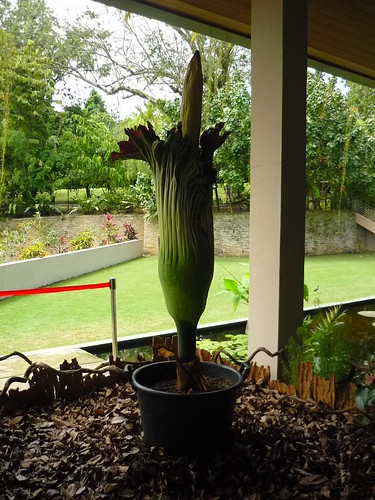
For a brief period, visitors to the Singapore Botanic Gardens will bear witness to what is probably a once in a lifetime event: the blooming of the titan arum (Amorphophallus titanum).
This native of equatorial rainforests in Sumatra holds the record of the largest unbranched inflorescence in the world, up to 3 metres in height. Like many of its smaller relatives in the aroid family (Araceae), the flower consists of numerous tiny flowers forming a central column known as the spadix, and this structure is sheathed in a modified petal-like leaf known as a spathe. As it blooms, the spathe unfurls and rolls back, revealing the spadix.

Immature titan arum flower, University of California Botanical Garden;
(Photo by Kostas Pagiamtzis)

Titan arum in full bloom, Kew Gardens;
(Photo by KewExplorer)
You would think that such a huge flower would be very fragrant, but to put it frankly, the titan arum's essence won't be captured in the latest range of perfumes anytime soon. The smell it gives off is that of rotting meat - its name in Bahasa Indonesia is bunga bangkai (bunga "flower", bangkai "corpse"). The scent, which is strongest at night, attracts insects such as carrion beetles, flesh flies, and sweat bees, and it is believed that one or more species of these scavenging insects pollinate the titan arum. If pollination is successful, the spathe falls off, and as the fruits ripen, they turn bright red, attracting frugivorous birds such as hornbills, which swallow the fruit whole and help disperse the seeds.

Fruits of titan arum, Kew Gardens;
(Photo by duncan)
You can see the blooming of one such titan arum in this video, taken at the University of California Botanical Garden at Berkeley:
Blooms of the titan arum are noteworthy not just because of the impressive sight (and smell), but also because it is an event that lasts for only a few days. Furthermore, the titan arum does not bloom every year. This is partly to do with its interesting life cycle.
When it's not blooming, the titan arum actually looks very different; it produces a single huge umbrella-like leaf, which can reach 6 metres in height and more than 3 metres wide. The massive leaf stalk branches into smaller leaflets. So what appears to be a small tree is in actual fact a single enormous leaf!

Leaf of titan arum, Kew Gardens;
(Photo by Tim Waters)
This leaf lasts for over a year before dying. All the food made by the leaf over the past year has been stored in the corm, a swollen underground stem that serves as a storage organ. Like the flower, the corm is another record-holder; the titan arum has one of the largest corms of any plant. One titan arum corm at Kew Gardens weighed 91 kilograms! The titan arum appears to lie dormant while some energy is expended to create a new leaf, which emerges and then continues the process of making and storing food in the corm. Only once in several years is there enough stored energy for a flower to develop.

Unpotted corm of titan arum weighing 41 kilograms, Gustavus Adolphus College;
(Photo by aeranthes)
Why is making the flower such an energetically expensive affair for the titan arum? The main reason is that the flower actually generates its own heat; in this study, the tip of the spadix was actually measured at 36 degrees Celsius, much higher than its surroundings. Apparently, heat production occurs in pulses, moving up from the base, and is also synchronised with the release of its fragrance. Some of the more important chemicals that give the titan arum its smell are sulphur-based compounds (such as dimethyl disulphide and dimethyl trisulphide) that do not become airborne easily. The plant heats itself up in order to volatilise its "perfume," enabling the smell to disperse further and attract more pollinators. This study sheds more light on heat production and the key role it plays in pollination. Also, as the temperature dips at night, a layer of cool air forms beneath the canopy. This hampers the dispersal of scent. By heating up the water vapour around it and causing it to rise, the titan arum is hence able to send its fragrance further afield. In this manner, the titan arum has solved the challenges of attracting pollinators in an environment where individuals are sparsely distributed, and where bright colours and smells can be hidden by the lush vegetation.

Night-time image of titan arum with flash photography (left) and (right) with thermal image (Image copyright: Jörg Szarzynski)

On the left, a normal flash-photography image of the flower and a group of people, and on the right, the same scene photographed with a thermal camera, showing that the flowers reach body temperature (Image copyright: Jörg Szarzynski)
This species is not alone in being a thermogenic plant; many other relatives in the Araceae also have blooms that produce their own heat.
How is the heat produced? This is why the titan arum needs to produce and accumulate so much food in the corm in the first place; by 'burning' the stored carbohydrates, the plant is able to generate large quantities of heat. Of course, its reserves are soon depleted, and the flower dies after a few days, leaving the corm to lay dormant once more and produce leaves in subsequent years to replenish its store of food. It should now be quite clear as to why the blooming of the titan arum is such a rare and short-lived event.
These posters from the University of Wisconsin-Madison Department of Botany beautifully illustrate the fascinating life cycle of the titan arum.

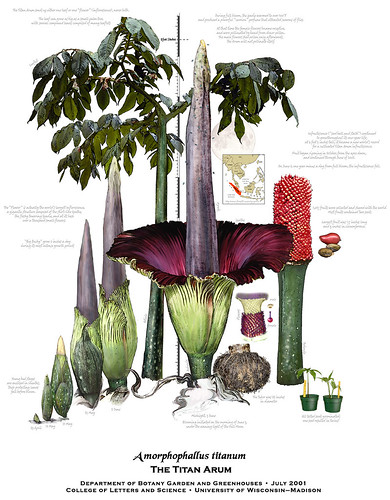
There are many websites devoted to the titan arum, where you can find out more details about its interesting biology. These include these pages here and here at the University of Wisconsin-Madison, this FAQ by Gustavus Adolphus College, and this page by Kew Gardens, as well as the accompanying information sheet.
Interestingly, the titan arum isn't the only giant flower in the Sumatran rainforest that smells like decaying flesh; the world's largest single flower, Rafflesia arnoldii, also reeks of decomposing meat, and is also found only in the rainforests of Sumatra. The main difference is that unlike rafflesia, which is a parasite whose host vines are found only in primary forests, the titan arum is free-living and grows in forest clearings.

Rafflesia arnoldii
(Photo by Prof KMS)
As you can see from the photos posted above, as well as its scientific name, the titan arum is a plant with a very phallic appearance; in fact, roughly translated from Ancient Greek, its name is somewhat appropriate: amorphos "without form, misshapen" + phallos "phallus" and titan "giant". So if you wanted to be blunt about it, you could call it the "giant misshapen penis flower". According to the Wikipedia entry, the common name of "titan arum" was coined by Sir David Attenborough, who felt that referring to it as Amorphophallus all the time was quite inappropriate for a prime-time popular television documentary. Yes, natural history documentaries do often showcase a fair bit of violence and sex, but they've still got to keep things relatively family-friendly. Mentioning Amorphophallus every other minute while talking about a giant phallic flower might raise giggles among many viewers, but would surely invite a flurry of complaints from indignant and outraged prudes.
(As an aside, Monty Python is awesome)
In any case, Sir David Attenborough featured the titan arum in the 1995 BBC TV series The Private Life of Plants, in which the flowering and pollination of the plant were filmed for the first time. This is the relevant segment discussing the titan arum:
So, you have here a giant flower that grows 3 metres high, looks like a giant misshapen penis, smells of rotting meat, blooms only once in several years, and actually produces its own heat? And for the first time ever, it's about to bloom in Singapore?
Naturally, lots of people were extremely excited.
The Singapore Botanic Gardens had set up a special display area on the titan arum, with the still-closed flower as the centerpiece. Initially, it was expected to open between 17 and 20 November, and people were visiting the Botanic Gardens just to check on the titan arum.
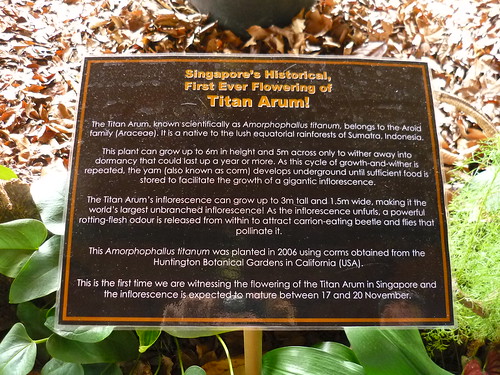
Life in this Garden City: Titan arum (13th November)
Orchids and the City: Amorphophallus titanum flowering in Singapore Botanic Gardens- Nov 2010 (18 November)
However, the expected dates rolled past, and we continued waiting with bated breath.
Alphernia's Blog: Titan Arum (21st November)
PurpleMangrove: 泰坦魔芋花(Titan Arum)含苞待放(morning,22nd,Nov) (22nd November)
PurpleMangrove: 泰坦魔芋花(Titan Arum)依旧含苞待放(7pm,24th,Nov) (24th November)
PurpleMangrove: 泰坦魔芋花(Titan Arum)仍然含苞待放(9am,26th,Nov) (26th November)
PurpleMangrove: 泰坦魔芋花(Titan Arum)仍含苞待放(9am,28th,Nov) (28th November)
Credit must be given to the author of PurpleMangrove for giving such regular updates on the status of the titan arum. I'm sure I'm not the only one who eagerly awaited the latest progress by checking out PurpleMangrove's posts.
PurpleMangrove: 泰坦魔芋花还是没有开放 The flower of Titan Arum is still not open :( (2nd December)
PurpleMangrove: 泰坦魔芋花(Titan Arum)即将绽放Opening soon(4th,Dec) (4th December)
Alphernia's Blog: Titan Arum – Not much development (4th December)
Alphernia's Blog: Titan Arum (4th December)
Eventually, many of us began to wonder if the titan arum was ever going to bloom or not. I'm sure the staff at the Botanic Gardens must have gotten tired of receiving calls from people asking if the titan arum had bloomed yet. And I'm sure I was not the only one who thought that it would have been excellent if the Botanic Gardens could have rigged up a live webcam feed so that we could check on its progress without having to make the trip repeatedly.
Then, on the morning of Sunday, 5th December, I saw this on my Facebook news feed:

And so, en route to our TeamSeagrass monitoring session, Andy and I dropped by the Botanic Gardens to see the titan arum for ourselves.
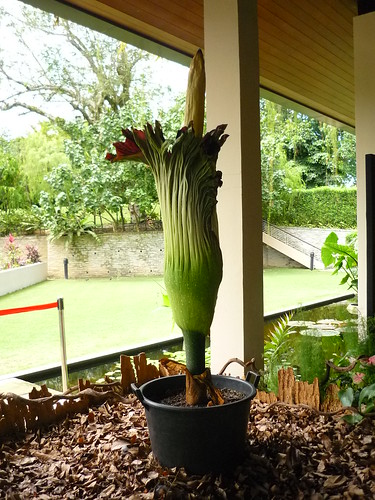
I have to say, it really is quite impressive to see a titan arum in person, even one that isn't in full bloom. There were quite a number of people who stopped to take photos.
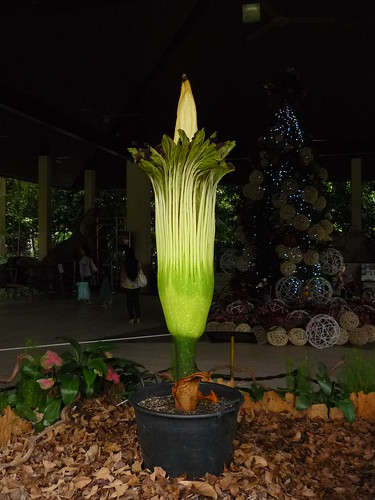
While Andy and I were there, we did catch whiffs of the stench. To me, it smelt as if a rat had died somewhere and started decomposing. And indeed, it was not a constant overpowering smell, just something that we detected every once in a while. All this time, there was a little cloud of flies happily buzzing around the apex of the spadix.
The rest of the display consisted of panels showcasing several other relatives of the titan arum found in the region.

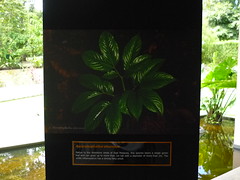
This one in particular caught my eye:
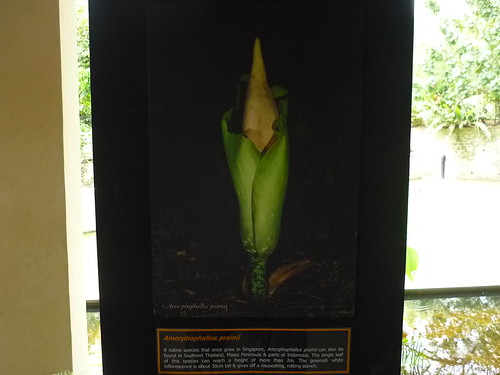
Yes, it's a species of Amorphophallus that's found in Singapore. Amorphophallus prainii is listed under A Checklist of the Total Vascular Plant Flora of Singapore as Critically Endangered. Compared to its giant cousin, this is a species of more modest proportions, with its flower reaching around 30 centimetres in height.

Here is a specimen of Amorphophallus prainii flowering in the Selangor forest.
I hope that the titan arum will open fully in the next few days. I would definitely want to drop by, even after work, if it means that I get the chance to view the titan arum in its full glory and get a full dose of its potent 'aroma'.
News that the titan arum had finally begun blooming started to spread. Over the next few days, people continued to drop by, hopeful that one day, after so many weeks of teasing, we would finally get to see it in full bloom.
tHE tiDE cHAsER: Titan Arum at Singapore Botanic Gardens (5th December)
PurpleMangrove: 泰坦魔芋花(titan arum)即将绽放opening soon(9am, 6th, Dec) (6th December)
PurpleMangrove: 泰坦魔芋花(titan arum)即将绽放opening soon(8pm, 6th, Dec) (6th December)
Keith Reve posted several videos on Facebook, documenting the daily ever so subtle changes in the flower.
[5th December]
23:20 (1:51)
[6th December]
01:00 (2:28)
01:15 (1:07)
19:00 (1:34)
19:00 (0:47)
[7th December]
23:00 (1:49)
23:10 (1:00)
[8th December]
18:30 (0:45)
no time stated (1:11)
Kok Sheng also gave us updates via Twitter:

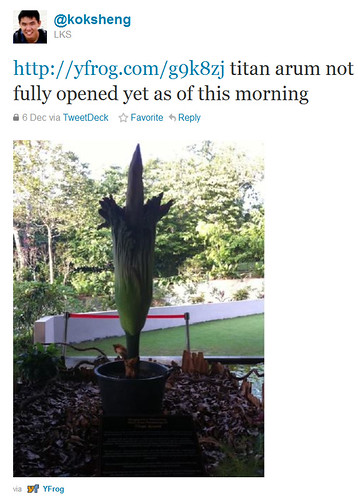

The waiting game resumed...
PurpleMangrove: 泰坦魔芋花(titan arum)即将绽放opening soon(8am, 7th, Dec) (7th December)
PurpleMangrove: 泰坦魔芋花(titan arum)慢慢开opening sloooowly(8am, 8th, Dec) (8th December)
PurpleMangrove: 泰坦魔芋花(titan arum)盛开还是凋零will fully open or close?(9am, 9th, Dec) (9th December)
Eventually, on 9th December, the blooming of the titan arum came to an anti-climactic end.
We first caught wind from Chay Hoon, who tweeted:

Then, Keith Reve himself updated his Facebook status:

And with 2 final videos:
Final video of the Titan - spathe has folded up & spadix has flopped downwards (1:14)
Final tribute to the Titan (1:52)
PurpleMangrove: 再见,泰坦魔芋Say good bye to Titan (8am,10th,Dec) (10th December)
So, it appears that this bloom of the titan arum did not quite meet up to expectations. Why it did not open up fully is a mystery, but I guess we'll have to wait and see what happens next. The waiting game carries on...
Note: Here's a guide on cultivating your very own titan arum, if you have the space and resources.